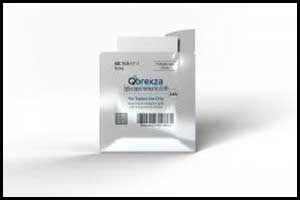- Home
- Editorial
- News
- Practice Guidelines
- Anesthesiology Guidelines
- Cancer Guidelines
- Cardiac Sciences Guidelines
- Critical Care Guidelines
- Dentistry Guidelines
- Dermatology Guidelines
- Diabetes and Endo Guidelines
- Diagnostics Guidelines
- ENT Guidelines
- Featured Practice Guidelines
- Gastroenterology Guidelines
- Geriatrics Guidelines
- Medicine Guidelines
- Nephrology Guidelines
- Neurosciences Guidelines
- Obs and Gynae Guidelines
- Ophthalmology Guidelines
- Orthopaedics Guidelines
- Paediatrics Guidelines
- Psychiatry Guidelines
- Pulmonology Guidelines
- Radiology Guidelines
- Surgery Guidelines
- Urology Guidelines
Qbrexza -First drug for treating Primary Axillary Hyperhidrosis

The Food and Drug Administration (FDA) approved Qbrexza (glycopyrronium) cloth for the topical treatment of primary axillary hyperhidrosis, a common condition of excessive underarm sweating that can affect the social lives of people, announced Dermira, Inc., a biopharmaceutical company.
Hyperhidrosis, which is sweating in excess of that required for normal thermoregulation, is a condition that usually begins in either childhood or adolescence. Although any site on the body can be affected by hyperhidrosis, the sites most commonly affected are the palms, soles, and axillae.
Qbrexza is the first FDA-approved, once-daily, topical prescription treatment indicated for people with primary axillary hyperhidrosis aged ≥9 years.
Primary axillary hyperhidrosis, also commonly known as excessive underarm sweating, is a chronic medical skin condition that results in sweating beyond what is needed for normal body temperature regulation. Qbrexza is applied directly to the skin and is designed to block sweat production by inhibiting sweat gland activation. The chronic, medical skin condition is estimated to affect nearly 10 million people in the U.S.
“For years, dermatologists have been telling us of the need for new treatment options that address primary axillary hyperhidrosis given the stigma and burden associated with this condition,” said Tom Wiggins, chairman and chief executive officer at Dermira. “From the start, our goal was to develop an approach that went beyond masking a person’s excessive underarm sweating and instead focused on treating the condition in a clinically meaningful way. We partnered with dermatologists and the FDA during the development stage and listened to the people who have been living with this condition to understand how they would define a meaningful benefit. It is our hope that Qbrexza will not only provide the clinical benefit these sufferers have been seeking but help to reduce the overall burden on their lives.”
Qbrexza bagged the approval after the results from two Phase 3 clinical trials, ATMOS-1 and ATMOS-2, which evaluated the efficacy and safety of Qbrexza in patients with primary axillary hyperhidrosis. Both trials assessed the absolute change from baseline in sweat production (the weight or amount of sweat a patient produced) following treatment with Qbrexza and the proportion of patients who achieved at least a four-point improvement from baseline in their sweating severity, as measured by the Axillary Sweating Daily Diary (ASDD), Dermira’s proprietary patient-reported outcome (PRO) instrument. The PRO was developed in consultation with the FDA and in accordance with the agency’s 2009 guidance on PRO instruments.
Side effects of Qbrexza include blurred vision, constipation, burning and itchy skin, head and throat pain, and dry mouth, eyes, and skin.
Qbrexza is contraindicated in patients with medical conditions that can be exacerbated by the anticholinergic effect of Qbrexza (e.g., glaucoma, paralytic ileus, unstable cardiovascular status in acute hemorrhage, severe ulcerative colitis, toxic megacolon complicating ulcerative colitis, myasthenia gravis, Sjogren’s syndrome).
Qbrexza is expected to be available for prescribing in October 2018.

Disclaimer: This site is primarily intended for healthcare professionals. Any content/information on this website does not replace the advice of medical and/or health professionals and should not be construed as medical/diagnostic advice/endorsement or prescription. Use of this site is subject to our terms of use, privacy policy, advertisement policy. © 2020 Minerva Medical Treatment Pvt Ltd